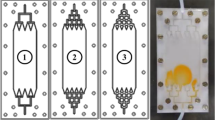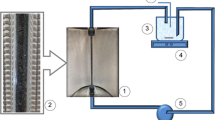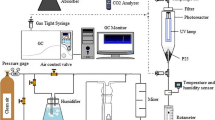Abstract
The application of photochemistry in larger scales relies on studies in photoreactor engineering. This report investigates the structural parameters of externally irradiated micro-structured photochemical packed bed reactors (PBRs). It reports on the impacts of the size and material of spherical packings on the reactor ability to harness incoming photons. Tubular reactors were built from borosilicate glass tubes of two outer diameters (20 and 30 mm) packed with soda-lime glass spheres of three average diameters (1.0, 3.0 and 6.0 mm), alumina spheres (6.0 mm dia.), and polished iron spheres (5.0 mm dia.). The aqueous-phase oxidation of benzoic acid by oxygen radicals generated by UV-A irradiation of nitrite ions was used as a model homogeneous photochemical reaction. It was observed that increasing the D/dp ratio for the narrower reactors led to improved specific yields (\({\tilde Y_{3.0mm}} = 1.05{\tilde Y_0}\)), suggesting that intensification is possible in these reactors. Lastly, it was found that glass spheres can be replaced by alumina spheres with considerably little loss in the light-collection efficiency (ca. 20%), indicating an attractive pathway for fixed-bed solar photocatalysis.
Similar content being viewed by others
Abbreviations
- \({\bar \phi _{ + {\rm{SA}}}}\) :
-
Average (weighted) quantum yield of salicylic acid formation (mol SA absorbed-einstein−1)
- \(\phi _{{\rm{ + SA}}}^\lambda \) :
-
Spectral quantum yield of salicylic acid formation (mol SA absorbed-einstein−1 nm−1)
- \(\phi _{{\rm{P,0}}}^\lambda \) :
-
Spectral incoming photon flow (einstein s−1 nm−1)
- ϕPabs:
-
Photon absorption rate (einstein s−1)
- ϕP0:
-
Incoming photon flow (einstein s−1)
- Ci:
-
Concentration of species i (mol dm−3)
- L:
-
Length of the reactor (m)
- LRS:
-
Length of the reaction space (m)
- Q:
-
Volumetric flow rate (cm3 s−1)
- t:
-
Elapsed time from irradiation start (s)
- tm:
-
Average residence time (s)
- tRS:
-
Time on the reaction space (s)
- V:
-
Total volume of the system (cm3)
- ṅSA:
-
Salicylic acid generation rate (mol s−1)
- \(\bar Y\) :
-
Specific volumetric yield (mol m−3 einstein−1)
References
W. J. Ong, L. K. Putri, Y. C. Tan, L. L. Tan, N. Li, Y. H. Ng, X. Wen and S. P. Chai, Unravelling charge carrier dynamics in protonated g-C3N4 interfaced with carbon nanodots as co-catalysts toward enhanced photocatalytic CO2 reduction: A combined experimental and first-principles DFT study, Nano Res., 2017, 1–24.
H. Zhao, J. Chen, G. Rao, W. Deng and Y. Li, Enhancing photocatalytic CO2 reduction by coating an ultrathin Al2O3 layer on oxygen deficient TiO2 nanorods through atomic layer deposition, Appl. Surf. Sci., 2017, 404, 49–56.
Y. Ma, X. L. Wang, Y. S. Jia, X. B. Chen, H. X. Han and C. Li, Titanium Dioxide-Based Nanomaterials for Photocatalytic Fuel Generations, Chem. Rev., 2014, 114, 9987–10043.
H. Takeda, K. Ohashi, A. Sekine and O. Ishitani, Photocatalytic CO2 Reduction Using Cu(I) Photosensitizers with a Fe(II) Catalyst, J. Am. Chem. Soc., 2016, 138, 4354–4357.
Y. Yamazaki, H. Takeda and O. Ishitani, Photocatalytic reduction of CO2 using metal complexes, J. Photochem. Photobiol., C, 2015, 25, 106–137.
S. Xie, Q. Zhang, G. Liu and Y. Wang, Photocatalytic and photoelectrocatalytic reduction of CO2 using heterogeneous catalysts with controlled nanostructures, Chem. Commun., 2016, 52, 35–59.
V. Preethi and S. Kanmani, Performance of gas-phase photocatalytic reactors on hydrogen production, Int. J. Hydrogen Energy, 2015, 42, 8997–9002.
B. Ramos, S. Ookawara, Y. Matsushita and S. Yoshikawa, Intensification of solar photocatalysis with immobilised TiO2 by using micro-structured reaction spaces, J. Environ. Chem. Eng., 2015, 3, 681–688.
H.-P. Kuo, S.-W. Yao, A.-N. Huang and W.-Y. Hsu, Photocatalytic degradation of toluene in a staged fluidized bed reactor using TiO2/silica gel, Korean J. Chem. Eng., 2017, 34, 73–80.
L. A. Diniz, T. L. R. Hewer, D. Matsumoto and A. C. S. C. Teixeira, A comparison between the four Geldart groups on the performance of a gas-phase annular fluidized bed photoreactor for volatile organic compound oxidation, Environ. Sci. Pollut. Res., 2018, 1–11.
W. Ehrfeld, V. Hessel and V. Haverkamp, Microreactors, Ullmann’s Encycl. Ind. Chem., 2012, 173–198.
B. Ramos, S. Ookawara, Y. Matsushita and S. Yoshikawa, Intensification of Photochemical Wastewater Decolorization Process Using Microreactors, J. Chem. Eng. Jpn, 2014, 47, 136–140.
J. Liu, H. Shi, Q. Shen, C. Guo and G. Zhao, Efficiently photoelectrocatalyze CO2 to methanol using Ru(II)-pyridyl complex covalently bonded on TiO2 nanotube arrays, Appl. Catal., B, 2017, 210, 368–378.
L. Suhadolnik, M. Krivec, K. Zagar, G. Drazic and M. Ceh, A TiO2-nanotubes-based coil-type microreactor for highly efficient photoelectrocatalytic degradation of organic compounds, J. Ind. Eng. Chem., 2017, 47, 384–390.
L. Beevers and R. H. Hageman, Nitrate and nitrite. Photochem. Photobiol., 1980, 115, 115–168.
J. J. Jankowski, D. J. Kieber and K. Mopper, Nitrate and Nitrite Ultraviolet Actinometers, Photochem. Photobiol., 1999, 70, 319–328.
O. Zafiriou and R. Bonneau, Wavelength-dependent quantum yield of OH radical formation from photolysis of nitrite ion in water, Photochem. Photobiol., 1987, 45, 723–727.
J. Mack and J. R. Bolton, Photochemistry of nitrite and nitrate in aqueous solution: a review, J. Photochem. Photobiol., A, 1999, 128, 1–13.
B. M. da Costa Filho, A. L. P. Araujo, G. V. Silva, R. A. R. Boaventura, M. M. Dias, J. C. B. Lopes and V. J. P. Vilar, Intensification of heterogeneous TiO2 photo-catalysis using an innovative micro-meso-structured-photo-reactor for n-decane oxidation at gas phase, Chem. Eng. J., 2017, 310, 331–341.
Author information
Authors and Affiliations
Corresponding author
Rights and permissions
About this article
Cite this article
Ramos, B., Couri, A.P., Ookawara, S. et al. Micro-structured packed bed reactors for solar photocatalysis: impacts of packing size and material on light harnessing. Photochem Photobiol Sci 18, 577–582 (2019). https://doi.org/10.1039/c8pp00371h
Received:
Accepted:
Published:
Issue Date:
DOI: https://doi.org/10.1039/c8pp00371h




